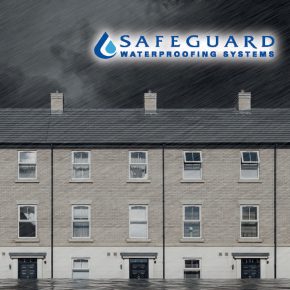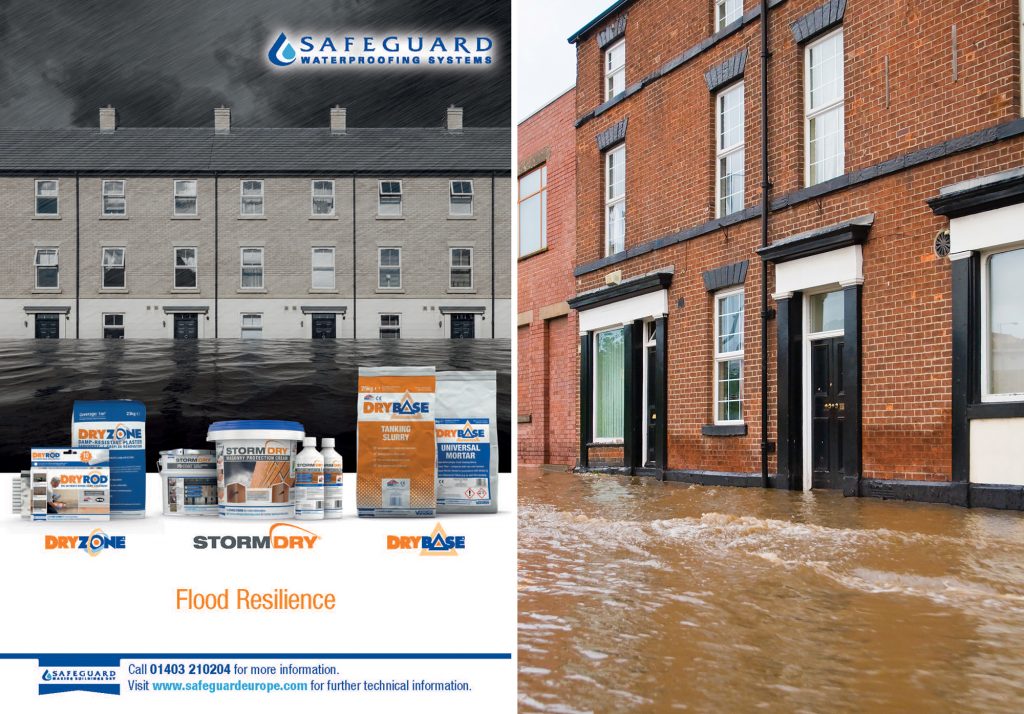
Safeguard Europe designs in flood resilience and resistance
It has never been easier to address the fundamentals of flood protection thanks to Designing for Flood Resilience and Resistance from Safeguard Europe.
The two main approaches to tackling flooding are water exclusion and water entry strategies – also known as flood resistance and resilience respectively – and Designing for Flood Resilience and Resistance is a simple guide to protecting property deploying both techniques.
Safeguard Europe has over four decades of experience in damp-proofing and waterproofing technology and has developed several flood management systems, which illustrate the various mechanisms by which flood water can enter a property and how to stop it, as well as detailing the internal and external remedial works necessary for habitable reinstatement.
Resistance is attempting to exclude water and can only be used only if typical flood water depths are 600mm or less. Beyond this depth, flood waters can inflict structural damage – and water entry, or resilience, is recommended.
Resilience is the ability to recover from a flood event and is the appropriate strategy to minimise (structural) damage in the face of flood waters over 600mm.

Due to the difficulty in achieving complete resistance to flood waters, designing for resilience offers a more robust strategy.
Selecting the correct approach is categorised into three flood systems that employ these strategies, or a mixture of each, to anticipate every flood scenario.
The foundation for the system is Flood System 1, which provides basic resilience by employing the company’s Dryzone Damp-Resistant Plaster and a specially designed lime-based skim coat as a flood resilient wall coating, together with a secondary chemical DPC rods installed above design flood height.
Unlike traditional gypsum plasters, these plaster and skim finishes retain their strength and dimensions under flood conditions and dry out quickly, while their alkaline content deters mould growth.
The secondary DPC is formed using Dryrod Damp-proofing Rods, while Drybase Liquid-Applied DPM should be applied to seal floors and lap the wall to just above the level of the primary DPC.
Deploying two strategies, resilience combined with basic resistance, Flood System 2 helps external walls resist flood water with Stormdry Masonry Protection Cream and Stormdry FD-Coat limiting the amount of water seeping through the walls and speeding up the drying time after a flood.

Flood System 2 incorporates all the measures in Flood System 1 – Dryzone Damp-Resistant Plaster and Dryrod Damp-proofing Rods – to ensure that the internal walls dry rapidly and can be redecorated quickly.
Flood System 3 boosts the level of protection to the internal walls by, in effect, tanking them with Drybase Tanking Slurry, a cementitious tanking product that provides waterproofing at negative pressures up to 5 bar.
This can be applied up to 0.6m to stop flood water getting into the premises and is particularly suitable where very low-level flooding (<0.3 m) is expected.
Providing flood repairable options, the guide also considers the Dryzone Express Replastering system which can be combined with all three packs for swifter results.
Dryshield Cream, a breathable salt and mould-resistant and water-repellent cream, goes on the walls to aid the drying out process while plasterboards are installed horizontally – for easy removal and replacement after flooding – and secured with Drygrip Adhesive, a salt- and damp-resistant glue.
The system allows for remedials and room reinstatement in around 24 hours. This represents not only a significant time-saving over more traditional methods, but also a significantly cleaner and more convenient approach.
This tackles many of the problems confronted by landlords, homeowners and tenants faced with decanting from property when protracted works are undertaken.
To download the guide to flood resistance, resilience, and water entry generally, visit safeguardeurope.com/applications/flooding.
Contact:
Safeguard Europe,
Redkiln Close,
Horsham,
West Sussex,
United Kingdom,
RH13 5QL
Phone: 01403 210204
Fax: 01403 217529
Visit Safeguard Europe's website
Visit Supplier's page
Latest news

26th March 2025
Encasement Verta column casings - covering up with style
The demands of architects and specifiers seeking to create stylish finishes on a diverse range of building interior and exterior projects are the main drivers behind the versatility and extensive choice available within the Encasement Verta column casing range.
Posted in Articles, Building Industry News, Building Products & Structures, Canopies, Entrances & Column Casings, Case Studies, Interior Design & Construction, Interiors, Restoration & Refurbishment, Retrofit & Renovation, Walls
26th March 2025
Pyroguard launches on-demand CPD webinar
Pyroguard has launched an on-demand version of its RIBA-approved CPD seminar – ‘Fire safety glazing: a system, not a product’ – in a bid to guide the industry regarding the critical role of fire safety glass.
Posted in Articles, Building Industry Events, Building Industry News, Building Products & Structures, Building Services, Continuing Professional Development (CPD's), Glass, Glazing, Health & Safety, Information Technology, Innovations & New Products, Posts, Retrofit & Renovation, Seminars, Training, Windows
25th March 2025
Reduce sound transference with West Fraser CaberAcoustic
CaberAcoustic from West Fraser is a highly versatile, effective and economical sound-reducing flooring solution. Reducing both impact and airborne transmitted sounds, it can be laid over concrete and timber floors in both new and existing buildings.
Posted in Acoustics, Noise & Vibration Control, Articles, Building Industry News, Building Products & Structures, Building Services, Building Systems, Facility Management & Building Services, Floors, Interior Design & Construction, Interiors, Posts, Restoration & Refurbishment, Retrofit & Renovation, Timber Buildings and Timber Products
25th March 2025
Vent-Axia Kicks Off Charity Football Tournament in Support of Cancer Research UK
Ventilation leader Vent-Axia brought together leading building design professionals for an action-packed Charity Powerleague 5-a-side Football Tournament on Thursday 20th March in Shoreditch, London, in aid of Cancer Research UK.
Posted in Air Conditioning, Articles, Building Industry Events, Building Industry News, Building Products & Structures, Building Services, Charity work, Facility Management & Building Services, Heating, Ventilation and Air Conditioning - HVAC
 Sign up:
Sign up: